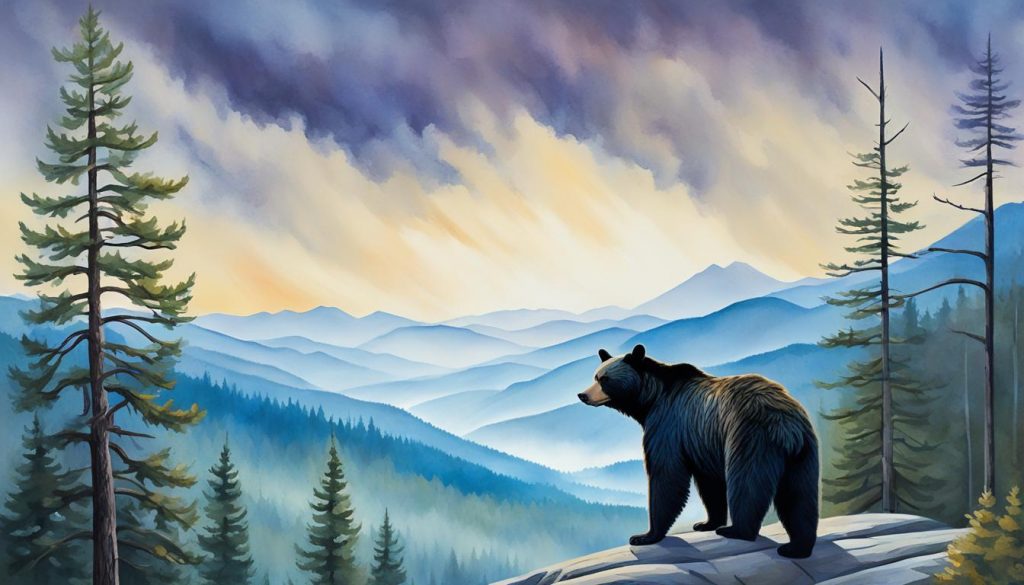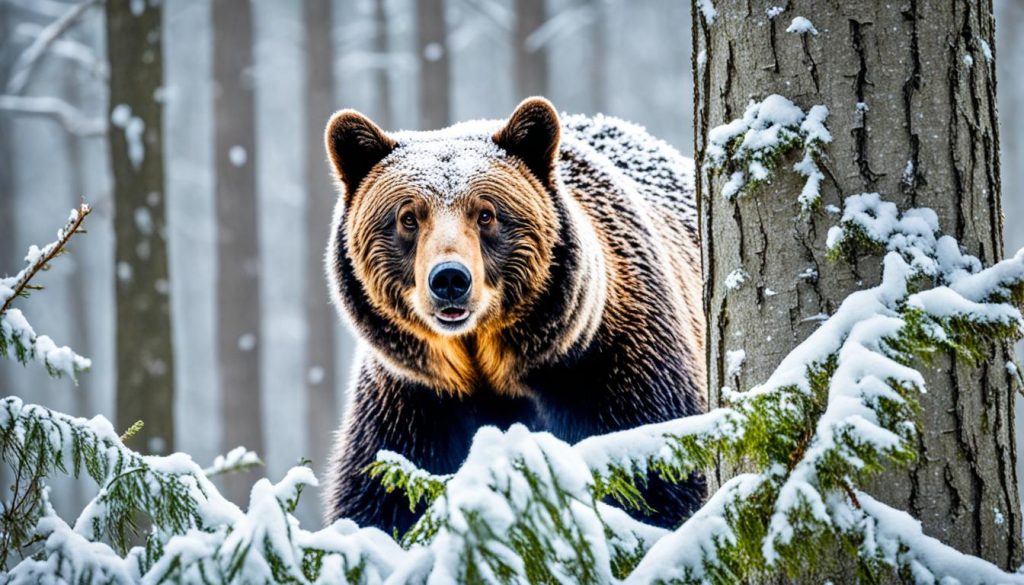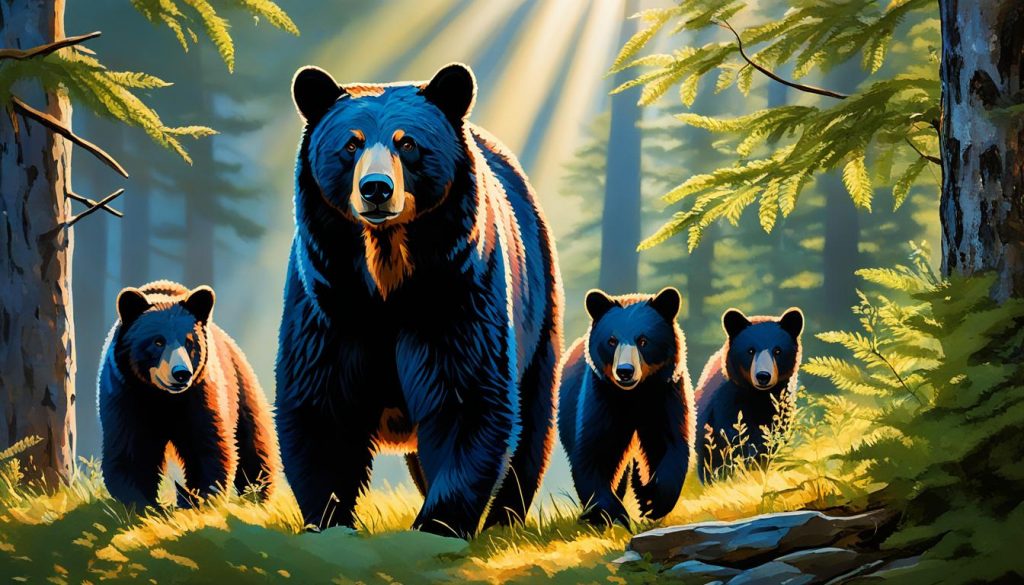
What to See and Do with Black Bears in the Smoky Mountains
Black bears are a common sight in the Great Smoky Mountains National Park, making it a popular destination for wildlife enthusiasts. With an estimated population of 1,500 bears, visitors have a good chance of encountering these magnificent creatures in their natural habitat.
However, it is important to remember that black bears are wild animals and should be observed from a safe distance for both your safety and theirs. Approaching bears within 50 yards is illegal and can result in dangerous situations.
Before planning your hike or exploration in the Smoky Mountains, check the bear closures and warnings in the park. This will ensure you avoid any areas with recent bear activity and reduce the risk of bear encounters.
Another important consideration is to keep your pets on a leash at all times. Dogs can provoke bear encounters, which can be dangerous for both your pet and the bear. Be responsible and respectful of the wildlife and their habitat.
In the next sections, we will provide you with tips for safely viewing black bears in the Smoky Mountains, as well as the top places where you can spot these majestic creatures. We will also discuss bear safety and conservation measures that are crucial for the well-being of both visitors and the black bear population in the Smokies.

Tips for Safely Viewing Black Bears in the Smokies
When exploring the Smoky Mountains and encountering a black bear, it is vital to prioritize safety and adhere to proper bear viewing practices. The Smoky Mountains are home to a diverse population of black bears, and understanding their behavior is crucial for a safe and enjoyable experience. By following these tips, you can make the most of your bear sightings while also contributing to black bear conservation in the Smoky Mountains.
Firstly, it is essential to always remain watchful and never approach a black bear. Maintaining a safe distance is key to avoiding potentially dangerous encounters. If the bear is far away and displays no signs of aggression, it is safe to observe from a distance using binoculars or a telephoto lens.
However, if the bear starts to exhibit interest in your presence or changes its behavior, it is an indication that you are too close. In such situations, it is crucial to slowly back away while keeping a close eye on the bear. Ensure that you do not turn your back to the bear and maintain a calm and assertive demeanor.
In persistent encounters where the bear continues to approach or display aggressive behavior, it may be necessary to act assertively to deter the bear. This can include making loud noises, such as clapping or shouting, to show dominance and scare the bear away. Additionally, throwing non-food objects, such as small rocks or sticks, can help reinforce the idea that humans are not a source of food.
Reporting any bear incidents to park rangers is of utmost importance for the safety of both visitors and bears. By notifying park authorities, they can evaluate the situation, take appropriate action if necessary, and gather valuable data to better understand and protect the black bear population in the Smoky Mountains. This helps in ongoing black bear conservation efforts and ensures a harmonious coexistence between humans and bears within their natural habitat.
Remember, the Smoky Mountains offer a unique opportunity to explore black bears in their natural habitat, but it is essential to do so responsibly and with respect. By following these tips, you can enjoy memorable encounters with these magnificent creatures while contributing to their conservation and well-being.

Top Places to Spot Black Bears in the Smoky Mountains
For those eager to catch a glimpse of black bears in their natural habitat, the Great Smoky Mountains National Park offers several prime locations. These areas provide opportunities for black bear sightings, making them popular spots for avid bear watchers.
Cades Cove
Cades Cove is renowned for its picturesque landscapes and abundant wildlife, including black bears. This expansive valley is home to a thriving bear population, offering numerous chances to observe these magnificent creatures in their natural environment. Be sure to bring your binoculars for the best views!
Newfound Gap Road and Little River Road
Both Newfound Gap Road and Little River Road are scenic routes through the Smoky Mountains that provide ample opportunities to spot black bears. As you drive along these roads, keep an eye out for bears near rivers and streams, where they often search for food. It’s important to maintain a respectful distance and observe them from a safe vantage point.
Roaring Fork Motor Nature Trail
The Roaring Fork Motor Nature Trail is a hidden gem for bear enthusiasts. This winding trail showcases the beauty of the Smokies and is known for its breathtaking scenery. Early mornings and evenings are particularly favorable times to see black bears along the trail, so plan your visit accordingly.
Cataloochee Valley
If you’re seeking a serene and secluded area to observe black bears, make your way to Cataloochee Valley. This peaceful valley offers ample foraging opportunities for bears, making it an ideal location for bear sightings. Take a leisurely stroll along the valley floor and keep your eyes peeled for these majestic creatures.
Exploring the black bear sightings in the Smoky Mountains can be a thrilling and rewarding experience. Remember to always maintain a safe distance, use binoculars or telephoto lenses for a closer look, and never feed or approach the bears. By respecting their natural habitat, we can ensure the conservation and protection of these incredible animals for generations to come.
Bear Safety and Conservation in the Smoky Mountains
To ensure the safety of both visitors and bears in the Smoky Mountains, it is important to practice bear safety and conservation. Black bear conservation in Smoky Mountains is crucial for maintaining the delicate balance of this unique ecosystem. By understanding and respecting black bear behavior in the Smokies, we can take steps to protect both humans and bears.
One key aspect of bear safety is proper food storage. Bears are attracted to the scent of human food and garbage, and when they become accustomed to these food sources, it can lead to dangerous encounters. To prevent this, visitors should dispose of their trash in bear-proof dumpsters or cans. By keeping food and garbage securely stored, we can minimize the likelihood of bears searching for human food.
It is also important to never feed or approach bears in the Smoky Mountains. While it may be tempting to get closer for a better look or to capture a photo, this can put both visitors and bears at risk. Bears are wild animals, and approaching them can lead to unpredictable behavior and potentially dangerous situations. By observing bears from a safe distance and using binoculars or telephoto lenses, we can appreciate their majesty without interfering with their natural behavior.
Preserving black bear habitat in the Smokies is essential for their survival. This means respecting designated closures and warnings in the park, as well as being mindful of the impact we have on their environment. By staying on marked trails and reducing noise and disturbance, we can minimize our impact on the bears’ natural habitat and ensure their continued presence in the Smoky Mountains for future generations.
Source Links
- https://www.nps.gov/grsm/learn/nature/black-bears.htm
- https://www.cabinsusa.com/smoky-mountains-blog/post/328/best-places-to-see-bears-in-the-smoky-mountains.php
- https://smokymountainnationalpark.com/blog/see-bears-in-the-smoky-mountains/